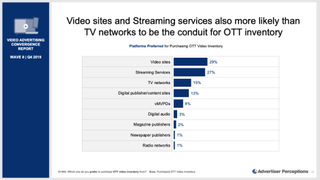Clients Prefer to Buy OTT Ads From Digital Vendors

The rush of ad supported streaming services being snapped up by big media companies isn’t necessarily good news for marketers and media buyers.
In a new survey by Advertiser Perceptions, brands and buyers said that with traditional TV losing viewers and reach, they prefer buying their digital video directly from over-the-top video sites rather than from established media companies.
Among those who have purchased OTT video inventory, when asked which they prefer to buy OTT inventory from, 29% said video sites and 27% said streaming services. Only 15% said TV networks, 13% said digital publisher/content sites and 8% said vMVPDs.
Even though they sometimes pay a premium, buyers like the newer companies because they are more flexible, offer better targeting and can be easier to deal with. That’s especially true for smaller companies--including online retailers and other direct-to-consumer brands--more used to dealing with digital publishers.

“Some newer to TV advertisers are more inclined to go to digital-first brands,” said Justin Fromm, executive VP for business intelligence at Advertiser Perceptions. “I think there’s going to be a lot of that.”
He added that traditional marketers, the ones who are TV advertisers are switching to AVOD and streaming services “because they also believe that’s where the viewership is. They believe they need to supplement their reach and reach the viewers who they believe are not watching linear television,” he said. “If you read the trades TV is getting older and older. Fewer and fewer people are watching and they’re skipping the ads. Where advertisers want to be is where there’s more on-demand viewing.”
That preference outweighs the fact that established media companies may be more reliable and offer better measurement and reporting.
Broadcasting & Cable Newsletter
The smarter way to stay on top of broadcasting and cable industry. Sign up below
And that’s a big reason why traditional media companies are snapping up ad-supported streaming services. Last year, Viacom bought Pluto TV. Last week, Comcast bought Xumo and there were reports that Fox was circling Tubi TV.
“I think that speaks to why we’re seeing these acquisition. The networks understand that any video dollars that go out of linear will go to the YouTube’s of the world and the streaming services,” he said.
“Networks also need AVOD technological capability fast,” Fromm added. “It’s quicker to buy it than build it, and then focus on the re-bundling of programming and audiences that network marketing teams are expert in.
In the survey, when buyers were asked where linear TV budgets will go, 20% said video sites, 13% said streaming services, 12% said social media sites, 9% said addressable linear TV, another 9% said TV network full-episode players. Other answers included data-driven linear TV, DSPs, Video Ad Networks, vMVPDs, Mobile Ad Platforms, Publisher/Content Sites and Set-Top-Box VOD.
And as the video world gets more complicated, ad dollars are being driven to digital. In the survey, when buyers were asked to agree or disagree with the statement: “All this confusion makes me want to buy more digital,” 55% agreed with only 17% disagreeing.
The Advertiser Perceptions study is based on more than 350 respondents, 44 with marketers and 56% with agencies.
Jon has been business editor of Broadcasting+Cable since 2010. He focuses on revenue-generating activities, including advertising and distribution, as well as executive intrigue and merger and acquisition activity. Just about any story is fair game, if a dollar sign can make its way into the article. Before B+C, Jon covered the industry for TVWeek, Cable World, Electronic Media, Advertising Age and The New York Post. A native New Yorker, Jon is hiding in plain sight in the suburbs of Chicago.










